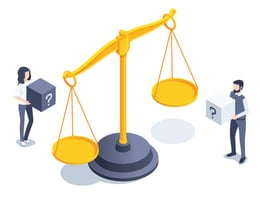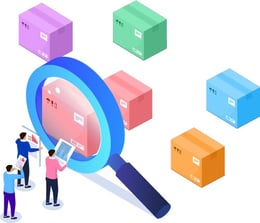 Choosing between two great options is a struggle for anyone. When faced with the decision, there can be a feeling of loss for the choices not selected. When it comes to ideas and group discussion, it can even feel personal. The more options thrown into the mix, the more challenging the decisions become.
Choosing between two great options is a struggle for anyone. When faced with the decision, there can be a feeling of loss for the choices not selected. When it comes to ideas and group discussion, it can even feel personal. The more options thrown into the mix, the more challenging the decisions become.
When generating many ideas for improving a product, it's important to distinguish the value and desirability of each of those possibilities. More selection does not automatically make the choices better; therefore, having a system that allows you to evaluate each option and make an informed decision at the end of the process makes it much easier.
That's why feature scoring is an essential practice in product development. When ideas flow in consistently, your team needs a method to receive, evaluate, and prioritize or discard those ideas to create the best possible product. Various feature-scoring methods are useful for sorting ideas and gaining clarity on your goals.
When Is Feature Scoring Necessary?
 Feature scoring is highly useful when your team has a high volume of ideas to navigate. A flood of ideas can build at several stages in a product's lifetime, from the initial development stages to introducing new iterations to extending the lifecycle of the product. Two crucial stages where feature scoring is necessary are when your teams are in the initial stages of defining a product and when your product is complex and requires working through a high volume of ideas for a large number of product features.
Feature scoring is highly useful when your team has a high volume of ideas to navigate. A flood of ideas can build at several stages in a product's lifetime, from the initial development stages to introducing new iterations to extending the lifecycle of the product. Two crucial stages where feature scoring is necessary are when your teams are in the initial stages of defining a product and when your product is complex and requires working through a high volume of ideas for a large number of product features.
Initial Stages of Product Development
The initial stages of developing a product require narrowing down ideas to define the product scope. You will already have established a vision for the product with multiple ideas of how to reach that vision. Using a feature scoring method helps your team evaluate your options and refine your ideas to create a strategic product plan.
Processing a High Volume of Ideas
Another time when feature scoring is valuable is when the product scope is highly complex. When you have a long list of features to define on your product and a series of suggestions for each component, you need a system to narrow down the suggestions. For example, when your teams must choose the details of thirty features that all support the product goal and work together seamlessly, you need a system that keeps you consistent and guides you to the right decisions.
What to Include in the Feature Scoring Process
 The feature scoring process may look different from team to team, depending on the scoring method or model used. For example, an organization that prefers the MoSCoW method will focus on prioritizing feature ideas based on the value they offer the customer. Teams that want to use the ICE Scoring model will assign a score to each feature idea based on its impact, the confidence your team has in the idea, and the ease with which it can be implemented.
The feature scoring process may look different from team to team, depending on the scoring method or model used. For example, an organization that prefers the MoSCoW method will focus on prioritizing feature ideas based on the value they offer the customer. Teams that want to use the ICE Scoring model will assign a score to each feature idea based on its impact, the confidence your team has in the idea, and the ease with which it can be implemented.
No matter what method you use, it's vital to always keep the end goal in mind. Do your top features align with the product vision and the product strategy? You'll also need to be clear in how you reached your decisions for transparency. Bias can appear in the feature scoring process, but having a plan and a method can help minimize that influence.
While each method has a specific focus, here is a list of factors that you might consider during the feature-scoring process:
- Impact on customer
- Market demand
- Technical feasibility
- Technical complexity
- Dependencies
- Scalability
- Risks
- Performance
- Cost estimation
- Benefit analysis
- User input
5 Reasons Why You Should Score Your Product Features
 We've discussed what feature scoring is, how it works, and when it's most useful. Now, let's examine why feature scoring is useful in product development.
We've discussed what feature scoring is, how it works, and when it's most useful. Now, let's examine why feature scoring is useful in product development.
1. Justify Your Decisions
Making product development decisions on a whim is never a good idea. Your choices must be based on research, data, and strategy. Using a scoring method ensures that you can justify your team's decisions on a product. It's also a useful tool to communicate with other stakeholders working on the product. When you can explain how and why you came to a decision on a feature, others will find it easier to collaborate and support the product vision. When you have evidence to back up your decision, you can revisit your process to replicate the success again or avoid mistakes.
2. Prioritize the Backlog
Every product team has a backlog to manage. The only way to know whether your backlog is overflowing with great ideas or a mixed bag is to use a scoring method. Shuffling through the backlog becomes easier when you know what criteria an idea needs to become a priority.
Understanding how your product delivers value to the customer helps you choose the right features from the backlog that support the product strategy.
3. Align Product to the Customer
Delivering value to the consumer is the surest way to help your product perform in the market. Keeping your end user at the forefront as you decide which features to implement and which ones to put aside is essential to ensure you make good decisions. Creating a score based on the needs and wants of the customer will improve the results of your prioritization discussions and help you decide which features to add to the product roadmap.
4. Product Market Fit
Your product needs to satisfy the customer as well as fit the market it's designed to serve. Not having clarity on the market demand for your product will make it challenging to decide on priorities, let alone on how to score your feature options. Staying up to date with market demands and the performance of the competition helps ensure the weight of your scoring reflects reality.
5. Strengthen Your Marketing
Assigning scores to your features also helps you communicate which parts of the product matter most. When you define your product well for your marketing department, they'll have an easier time marketing your product to the right audience. Marketing amplifies what you already have. If your product doesn't live up to what the customer needs and market demands, no amount of advertising will fix that dilemma.
Manage Your Feature Scoring Using Product Roadmap Management Software
As you work through the process of scoring and prioritizing your features, you can use a basic functional spreadsheet, or you can use visually appealing product roadmap software that allows all your stakeholders easy access to the results and process. At Gocious, we're continuously adding new capabilities to our product roadmap management software to make tasks like feature scoring easier and more transparent. Book a free demo to see it in action.


